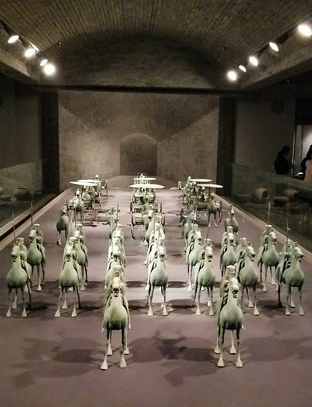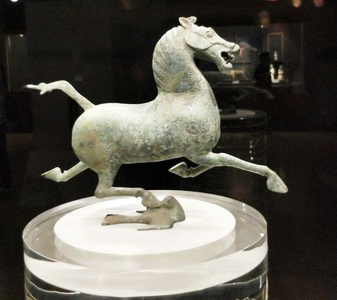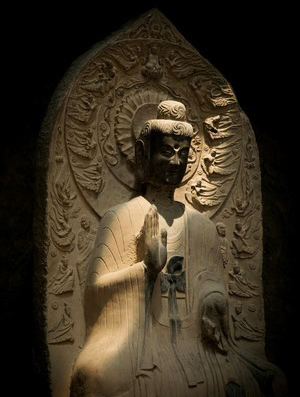
Based in the provincial capital of Lanzhou, the Gansu Provincial Museum is renowned throughout China for its comprehensive collection of stunning artefacts. It was originally founded in 1939 as the Gansu Scientific Education Centre and was renamed the Northwest People’s Science Museum in 1950, yet during this time it was dedicated entirely to the history of Gansu province. It wasn’t until 1956, after three years of renovations, that it would be re-purposed and become the sprawling museum that we see today. Nowadays, the museum covers an area of 18,000 square metres (193,750 sq. ft.) and is home to over 350,000 artefacts, making it one of the largest and most impressive museums in western China.
The most famous artefact housed in the museum is undoubtedly a bronze statue known as the “Flying Horse of Gansu.” Its English name is somewhat misleading, as its Chinese name of “Matafeiyan” (马踏飞燕) or “Horse Galloping, Flying Swallow” represents a far more accurate description of what it actually is. Dating back to the Eastern Han Dynasty (25 BC-220 AD), this bronze statue depicts a horse galloping, with three legs in the air and one hoof planted on the back of a flying swallow. The swallow itself has its head upturned in surprise to look at the horse, since it is understandably shocked by the situation!
The statue was discovered accidentally in 1969 near the city of Wuwei, when a group of local people were tasked with digging air-raid shelters. In the process, they unearthed a Han tomb belonging to General Zhang of Zhangye, who had once been responsible for maintaining imperial defences on the western frontier. It seems the general was not able to take his secrets to the grave after all! After alerting the provincial authorities to the discovery, the tomb was properly excavated by a team of archaeologists and the statue was found inside a chamber along with over 200 other bronze figures.

What makes the horse within the bronze statue particularly special is that it was based on a historically famous breed known as the Ferghana Horse. These “celestial horses” were highly prized throughout China as a status symbol and were renowned for their agility, which is why the galloping horse in the bronze is shown to be capable of outrunning a bird in flight. In fact, these horses were so valuable that Emperor Wu of the Han Dynasty (206 BC-220 AD) waged a war with the Greek Kingdom of Dayuan in the Ferghana Valley to get them, which came to be known as the War of the Heavenly Horses (102-104 BC). In short, there was no horsing around when it came to this much sought-after breed! Nowadays, the “Flying Horse of Gansu” has become a popular symbol throughout Gansu province, as evidenced by the huge replica of the statue that can be found outside of Lanzhou Railway Station.
The museum itself is spread out over three floors and is home to three permanent exhibitions. The first floor of the museum is made up of a temporary exhibition space, where the museum hosts a variety of different themed exhibitions throughout the year. Alongside this temporary space, the three permanent exhibitions are: the Silk Road exhibition and the Palaeontological Fossils of Gansu Province exhibition on the second floor; and the Painted Pottery of Gansu Province exhibition on the third floor.
According to historical records, the Silk Road was officially established after Emperor Wudi of the Han Dynasty dispatched an envoy named Zhang Qian to the Western Regions in the 2nd century BC. Over time, however, this simple trade route between China and Central Asia grew into a vast network of pathways that connected China to places as far-reaching as Africa and Europe. The term the “Silk Road” was first used in the 1870s by a geographer named Ferdinand Von Richthofen and was unsurprisingly so-named because of the Chinese merchants’ penchant for trading with silk, which was highly prized in ancient times.

The Silk Road exhibit within the Gansu Provincial Museum mainly focuses on the section of the Silk Road that was located within the Hexi Corridor, which can be found in Gansu province. The Hexi Corridor was a focal part of this historic trading route, as it was flanked by the desolate Tibetan Plateau in the north and the hostile Gobi Desert to the south. This meant that travellers along the road were all channelled through this corridor, which was littered with integral market towns such as Dunhuang and Wuwei.
The museum’s sprawling exhibit contains over 420 artefacts related to China’s trade relations with other countries, as well as detailed historical accounts of how the Silk Road was established. A few examples of these ancient treasures include: a pair of bells that date back to the Han Dynasty; wooden tablets that were used to relay messages along the Silk Road during the Han Dynasty; mural paintings from tombs belonging to the Northern Wei (386-535 AD) and Jin (265-420 AD) dynasties that were found near Jiayuguan in the Hexi Corridor; triple-coloured porcelain from the Tang Dynasty (618-907); a 2,000-year-old gilded silver plate embossed with an image of Bacchus, the Greek god of wine; and Buddhist statues from grottoes that were established along the Silk Road.
Once you’ve finished diving into the history of the Silk Road, the Palaeontological Fossils of Gansu Province exhibition is sure to satisfy the rest of your historical cravings. This exhibit is unsurprisingly dedicated to the numerous fossils that have been found throughout China, including dinosaur bones, fossilized plant specimens, and the contours of animals or plants that have been imprinted on stones. The exhibit itself is separated into four sections: the Palaeolithic Era; the Mesolithic Era; the Cenozoic Era; and the Department of Anthropology, which is dedicated to the evolution of prehistoric people who inhabited regions along the Yellow River.
Its most startling display, however, is undoubtedly the fully reassembled skeleton of a stegodon, also known as the Huanghe or “Yellow River” elephant. This colossal skeleton is 4 metres (13 ft.) tall and 8 metres (26 ft.) in length, with staggering 2-metre (6.5 ft.) long tusks! Alongside this exceptional elephant, the exhibit is also home to fossils belonging to the Mamenchisaurus sinocanadorum, which once roamed the region of modern-day Sichuan province and is believed to be the largest prehistoric animal to have inhabited China. Based on fossil evidence, it is estimated that the Mamenchisaurus sinocanadorum was nearly 15 metres (49 ft.) tall and 35 metres (115 ft.) long. To put that into perspective, that’s over twice the length of the average bus!
The third and final floor of the museum is home to a vast exhibit containing some of the most beautiful painted pottery from throughout Gansu province’s history. Gansu province is often regarded as the “hometown” of coloured pottery, as it is the place where the oldest coloured pottery in China was found. In fact, some of the ceramics on display originate from the Dadiwan culture (5800-5400 BC) and are over 6,000 years old, which attests to the venerable history of porcelain production in the region.